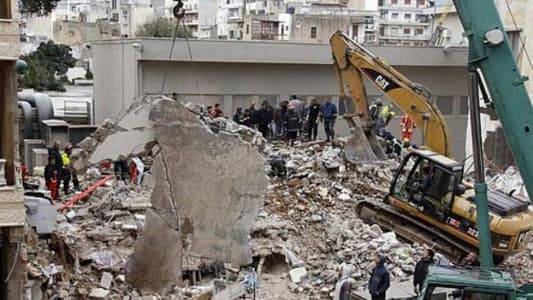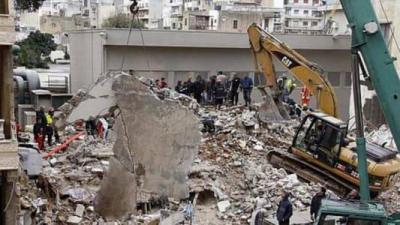The challenges facing Lebanon are escalating, along with the risks that hinder the safety, security, and stability of its citizens. This situation is exacerbated by natural factors that have made Lebanon one of the countries vulnerable to seismic risks in the Mediterranean region, combined with the state's negligence in fulfilling its responsibilities across various sectors, including ensuring the safety of residential buildings and guaranteeing the safety of their occupants.
The lack of reform policies from successive governments has once again highlighted the state's failure to find solutions for buildings threatened with collapse, whether due to natural factors like earthquakes and tremors or due to the persistent neglect of old buildings and the absence of engineering studies for constructions built contrary to the law. This prompted the head of the Lebanese Real Estate Authority, lawyer Andira Al-Zuhairi, to warn of "the implications of seismic tremors on residential buildings," reminding that "the number of buildings at risk of collapse exceeds 16,200 in Lebanon," including "more than 10,460 buildings in the Beirut Governorate alone, not counting the port area and its affected surroundings, followed by the northern region and Tripoli with 4,000 buildings," with the remaining figures distributed among the south, Mount Lebanon, and Bekaa.
This has also led the "Association of Owners of Rented Buildings" to warn of the consequences that may arise should neglect continue regarding the laws related to old buildings. This is to avoid holding them accountable for the collapse of such buildings, for which maintenance, renovation, and reinforcement responsibilities fall on the owner according to Article 18 of the Building Law.
In the absence of an updated survey of buildings at risk of collapse, specifically following the Beirut port explosion, Lebanese citizens have once again witnessed the tragic collapse of the "Murhaj Building" in Ashrafieh in 2020, the "Foual Building" in Mina Tripoli at the end of 2019, and the "Anan Building" in Bourj al-Barajneh in 2018, along with another five-story building in the Fassouh Ashrafieh area in 2012, resulting in approximately 27 casualties. This recalls the tragic incident at the "American" official mixed school in the Jabal Mohsen neighborhood of Tripoli, where student Magi Mahmoud (16 years old) lost her life due to a partial roof collapse.
While the law mandates that owners undertake necessary construction and reinforcement work, their reluctance forces the municipality to do so at the owner's expense, while the laws, including those related to public safety, remain mere ink on paper amid a lack of mechanisms, techniques, legislations, and financial resources to enforce them, compounded by the rising number of buildings constructed without permits, the absence of engineering studies, and the spread of random construction that has created chaotic urban conditions, legitimized through illegal building adjustments at the expense of public safety—a responsibility that primarily rests with the central government, followed by municipalities as local authorities.
Furthermore, specialists, including the Engineers' Association, also bear the responsibility of supporting those authorities with the required expertise and studies for either renovation or construction, before ultimately holding the building owner and the executing engineer accountable.
In response to the seismic disaster that struck southern Turkey and northern Syria, the head of the Engineers' Association in the north, Baha Harb, clarified to “Nida’ Al-Watan” that "the relief authority is forming a cell that includes, alongside them, the governor and representatives from municipalities and the Red Cross, to respond to any reports from citizens by sending a specialized engineering team to assess the damages and their risks to citizens' safety and provide recommendations for repairs or evacuating the damaged building." He pointed out that the engineering inspections are currently focused on buildings affected by seismic tremors, noting that the buildings that sustained cracks were not listed among the old buildings at risk of collapse in the markets.
He emphasized that the absence of engineering studies related to old buildings hinders their ability to assess risk levels when faced with natural disasters such as earthquakes and others. He confirmed that buildings constructed after 2005 and licensed by the Engineers' Association incorporated seismic safety factors in their structural studies, capable of withstanding tremors reaching approximately six degrees at a minimum.
In a related context, apart from the repercussions of natural factors (earthquakes) requiring a national rescue plan, former MP Engineer Imad Wakim called for proactive preparatory measures before disasters occur, emphasizing the importance of enforcing laws that mandate buildings to withstand earthquakes and monitoring the implementation processes, along with finding alternatives to existing lakes situated on seismic faults, like Lake Yammoune, which could explode and affect many surrounding towns. Amid the absence of an accurate survey of buildings at risk of collapse, he deemed that the majority of old constructions using sandstone require maintenance and reinforcement, necessitating a comprehensive plan and adequate budget allocation to ensure public safety in Lebanon.




